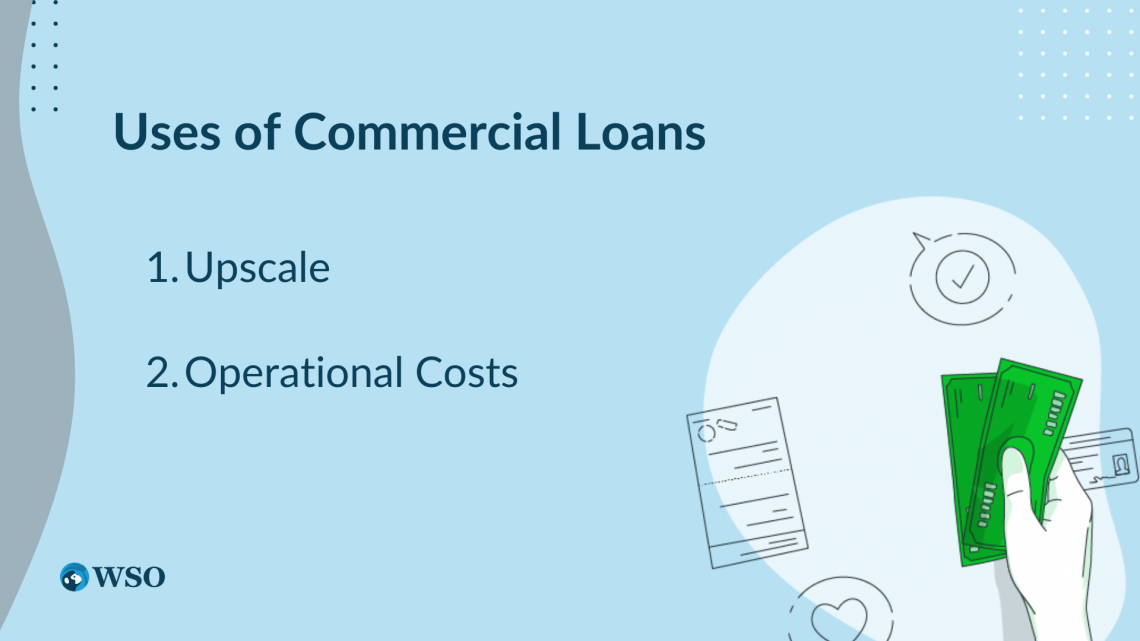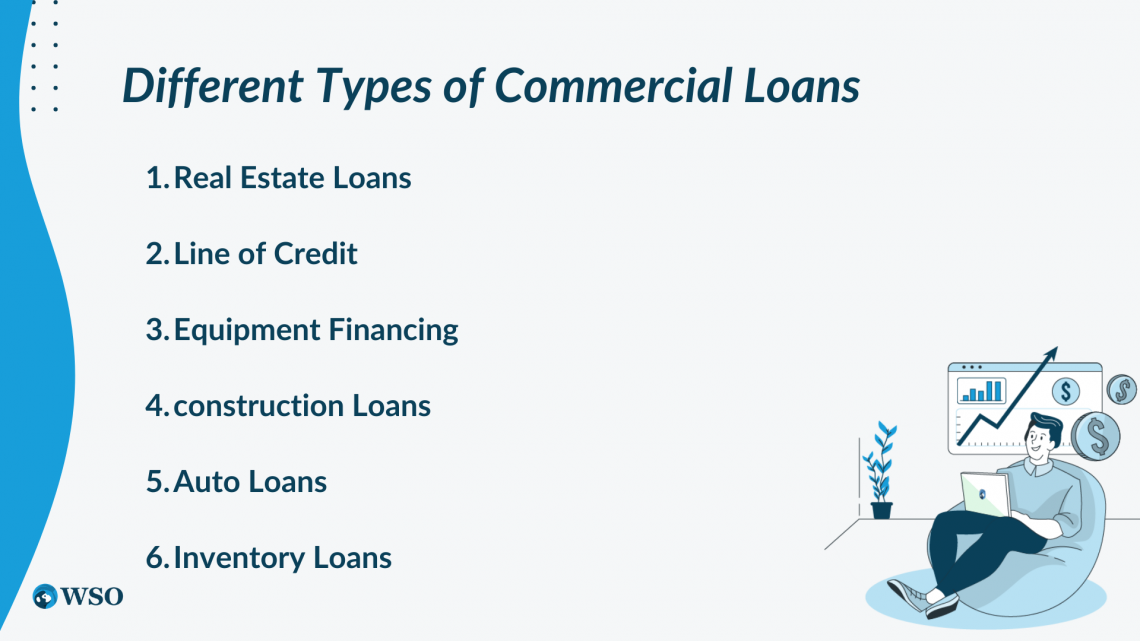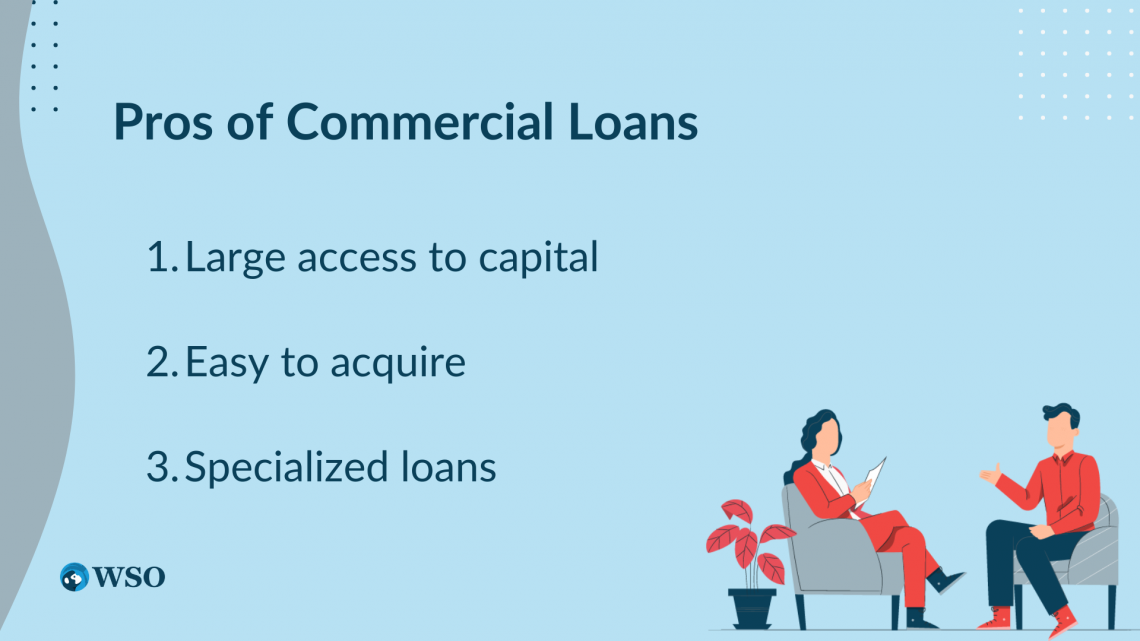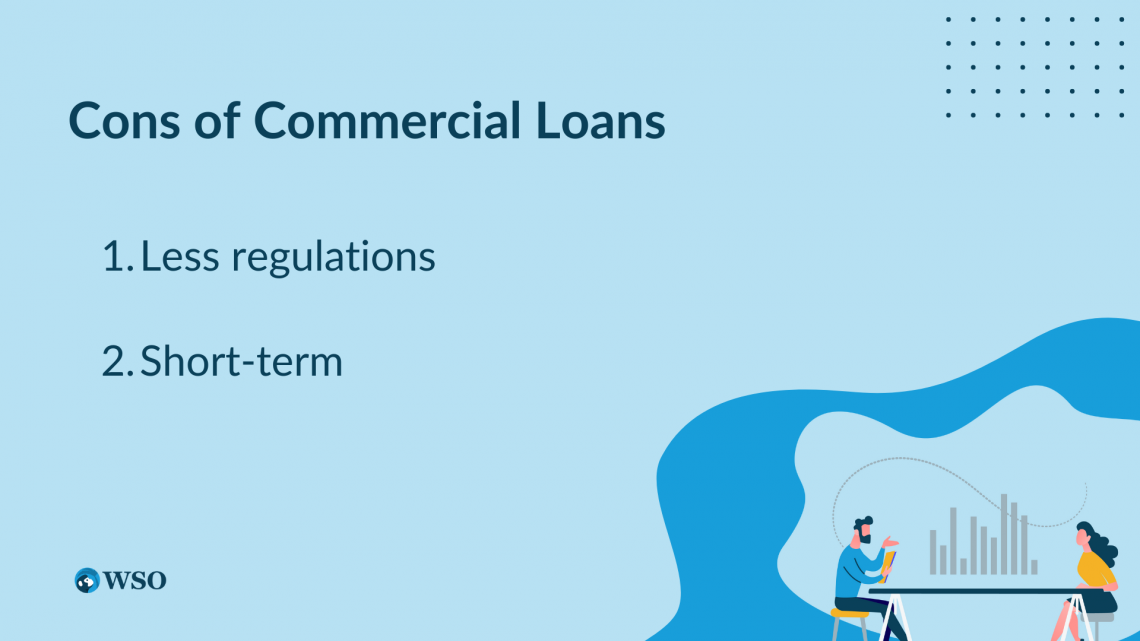Commercial Loan
A loan provided to businesses for commercial purposes, such as expanding operations or funding investments.
Commercial loans are loans between financial institutions like banks and businesses. These businesses usually use these loans to buy needed products and equipment or finance payroll.

Large businesses are the most popular borrowers of these loans. Challenges with financing a business are often the first hurdle of these large businesses. Up-front costs and recurring payments are the most common reasons for business failure.
These loans give these businesses access to short-term capital to help start their operations and begin their business.
Similar to the average consumer, these businesses don’t have access to large capital or equity off the bat. These loans become the main source of capital for these entities.
These loans are one of the backbones that push business forwards. Some banks will even specialize in these loans and promote business with better terms and added services, like business refinancing.
While some banks offer general commercial loans, banks like Bank of America can offer business-specific loans for real estate, construction, auto, and equipment.
Key Takeaways
- These Loans are used mainly by large corporations to finance business expenses
- Commercial loans provide capital to upscale machinery, employment, and real estate.
- There are multiple types of Commercial Loans that provide capital for different purposes.
- These loans operate like regular loans, except they are specifically tailored for large corporations.
- Compared to business loans, commercial loans have the right interest rates but a shorter repayment term
Uses of Commercial Loans
As stated, these loans are mainly used by businesses. These loans are part of a smaller sector of investment banking and, more specifically, loans.

Loans like these are generally short-term and are in large denominations that are catered to the aggressive markets of competing businesses.
Large corporations tend to acquire large amounts of debt or liabilities during their operations. These factors limit the amount of free cash a business has and their ability to expand. This causes the need for accessible capital.
It help with two main problems with businesses. Most businesses will have to finance their daily or monthly costs to stay in business or to finance an upscale.
If something happened to the business or sales dropped, a loan could be an option for the business to stay afloat.
1. Upscale
Cash through loans is often used to upscale. If a business plans to increase production or open a new facility in a different area, they need a large amount of capital. This capital isn’t often available or isn’t accessible.
Commercial loans serve to solve this problem. Once the loan is taken out, the business can upscale and increase production. If all goes well, the business’s profits will rise, and they can repay the loan.
2. Operational Costs
Besides expansion, these loans may be used to cover operational costs. In some years, profits will be shortened or completely cut. A loan taken out at the right time could keep a business afloat until profits begin to come in again.

Unexpected events could trigger a business to need to take out a loan. However, a business in a dire situation will have difficulty acquiring a loan due to its unpredictable situation.
Loans given out to these businesses will often require a large amount of downpayment, a larger sum of collateral, or a higher interest rate. Although these requirements burden a business, a loan could save a business from going under.
How Commercial Loans Operate
These loans operate similarly to most short-term loans. There is a lender (usually the bank) and a borrower (a business). When the borrower takes out a loan, the lender and borrower will enter into an agreement that the borrower will pay the loan back with interest.

Unfortunately, most businesses that just begin have no consistent cash flow. They are deemed to be a riskier borrower than the average person. This makes it a lot harder for loans to be given out to smaller businesses.
Even large businesses can’t always secure a commercial loan. Collateral is often needed to secure these specific loans. Collateral is assets put up to back a loan.
For small businesses, collateral can be in the form of equipment (machinery they use and operate with), real estate (the land that the business is built on), or even account receivables (future payments not yet gained).
With collateral secured, a bank is more likely to accept a business’s application for a loan. Collateral helps with securing and ensuring that the bank will make a profit or at the very least, lose a minimal amount of money on the loan.

After the loan is accepted, most terms dictate a monthly payment on the loan. Alongside monthly payments, the business will need to pay the loan back with interest. Interest can be seen as the cost of borrowing money. With interest, banks are able to lend money and make a profit.
Interest can be based on a multitude of factors like credit score, the business health, how much of a down payment the business made, interest rate type, and loan type. A change in interest can determine how much more a business will need to pay on a loan.
Commercial Loans vs. Business Loans
Commercial loans are similar to business loans, although these loans are larger and are used by large corporations. In contrast, business loans are generally tailored for smaller businesses with less recognition and assets.

Even though both these loans serve similar purposes, there are some differences that make each loan distinct.
1. Commercial
Larger businesses often are pushed to take out these loans. These loans often have more favorable terms as the company that takes out these loans has brand recognition and a secured cash flow.
Often, these large businesses take out these loans when they require a large capital injection.
Unfortunately, these loans are given by large banks. This allows less regulation to affect these loans.
2. Business
These loans will be targeted toward smaller-scale businesses. Local places with limited real estate would fit the bill. Businesses under this profit will often be protected by the SBA (Small Business Association).
NOTE
If you are a small business, a SB loan should be your first option. They provide great benefits for smaller businesses. Research them at the SBA.
This branch of the government will often have regulations towards banks on lending and interest rates with these smaller companies to protect them and promote an economy with smaller businesses.
The SBA also protects businesses from harassment and aggressive incorporation. It is a smart idea for small businesses to align themselves with this association as it can provide benefits not only for loans but other aspects of aggressive competition.
Different Commercial Loans
Although commercial loans will serve the same purpose, there are multiple types and each has its own lending term, conditions, and interest. Each loan offers its own benefits and downsides. It is important to know the differences and which ones are best for a business.

1. Real Estate Loan
As the name implies, these loans are used to buy property and real estate. Companies use these loans to acquire land to expand or store inventory. Loans under this section often use the real estate bought as collateral for the loan.
Even these loans fall into smaller sectors such as permanent loans, which act as a first mortgage on a property, or blanket loans which cover the cost of multiple properties.
2. Line of Credit
Lines of Credit act like credit cards. There isn’t an initial deposit of money to the business. Similar to a credit card, there is a limit to how much money the business can take out per month, or per year.

Once you take out a certain amount, you pay it off like a loan, but you only need to repay the amount you took with interest. The rest of the unused money is not collected by the bank, nor is it required by you to pay it.
These loans are fantastic for businesses that frequently borrow smaller sums of money.
3. Equipment Financing
Large machinery is extremely expensive but also a great investment. Price tags in the $100,000s can be bought with commercial loans. The machinery is bought outright by the bank and is given to the business.
While the business uses the machinery, it pays off the loan monthly. These loans are much easier to apply for since the equipment is used for collateral.
4. Construction Loan
A construction loan is similar to a real estate loan, except they are used to finance future construction and buildings. These buildings can be facilities or factories for cooperation—even large storage areas for goods.
5. Auto Loan
Large wise-scale companies need to travel and deliver goods to all parts of the world. One of the most popular forms of delivery are trucks and automobiles. These large vehicles are not cheap!

Investing in a large delivery fleet can help a company grow beyond using shipping services and offsetting the fee that these services have.
6. Inventory Loans
Inventory for most businesses is materials. For clothing companies large amounts of cloth and textiles are needed to sell their products. Although these materials are cheap in small quantities, large bulk orders can stack up and be a large source of operational costs.
These loans allow companies to buy materials before using them to prepare to produce products before the current products are sold.
Pros and Cons of Commercial Loans
While these loans offer a great way for large businesses to acquire capital, they do come with some downsides.
The pros are:

1. Large access to capital
These loans give businesses large access to capital. Up into the hundreds of thousands, if not millions, for the largest corporations
2. Easy to acquire
Most of these loans are generally given out to large businesses with brand recognition. These loans are low-risk for banks so they are eager to give them out.
3. Specialized Loans
There are multiple types of loans given out to finance specific costs. Each loan when used appropriately makes the process of taking out and paying back a loan easier.
For instance, if you wish to take out a loan for machinery, loans specified for machinery can allow you to use the machinery bought as collateral. This helps to push the loan forward and make the process quicker.
The cons are:

1. Less regulation
Compared to most loans and SBA loans, Com. loans have the least regulations. This can produce loans with less favorable terms and conditions.
2. Short-term
These loans are extremely short-term. They serve to finance a business to expand or pay for their expenses. This makes these loans risky as the bank doesn’t know if the business will succeed.
Summary
Commercial loans are a great option for corporations to raise capital. Most banks offer better ranks to larger cooperation rather than smaller businesses.

They follow a similar formula to a personal loan. Once a business takes out a set amount of money to finance its expenses, it will begin to pay off its loan on a monthly basis. Although there is also interest, some loans are charged differently from a traditional personal loan.
These loans can help corporations to expand into new markets or expand the business, and cover expenses. Costs like wages, or inventory prices are some of the most burdensome costs that businesses have.
A commercial loan can be taken out to save a failing company and give them an extra month or months to regain sales and save their company,
Compared to a business loan made for smaller businesses, these loans are often larger and have better specialization. There are multiple loans made for specific purposes such as Real Estate, Inventory, and Equipment loans.
Research and Written by William Hernandez-Han | LinkedIn
Free Resources
To continue learning and advancing your career, check out these additional helpful WSO resources:









or Want to Sign up with your social account?